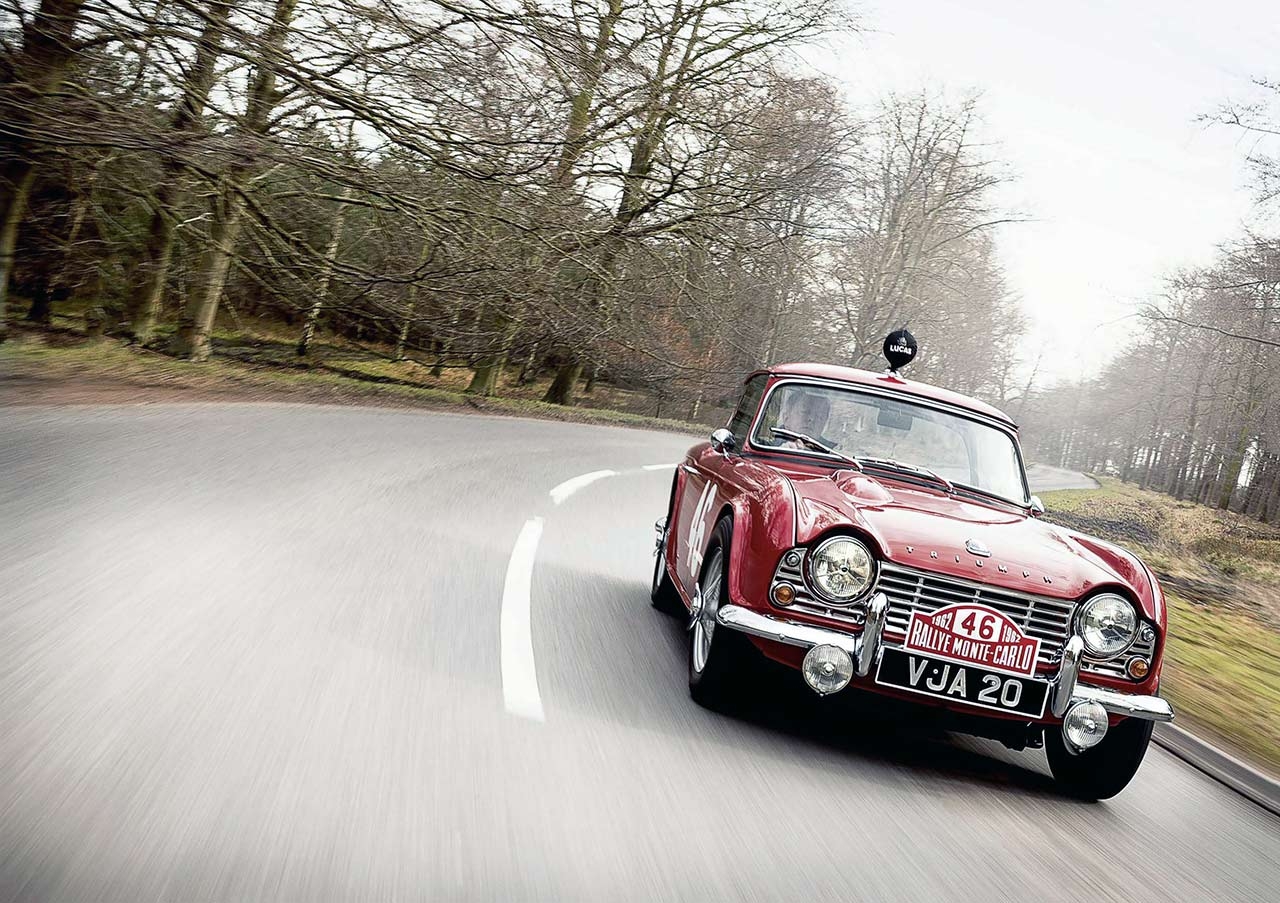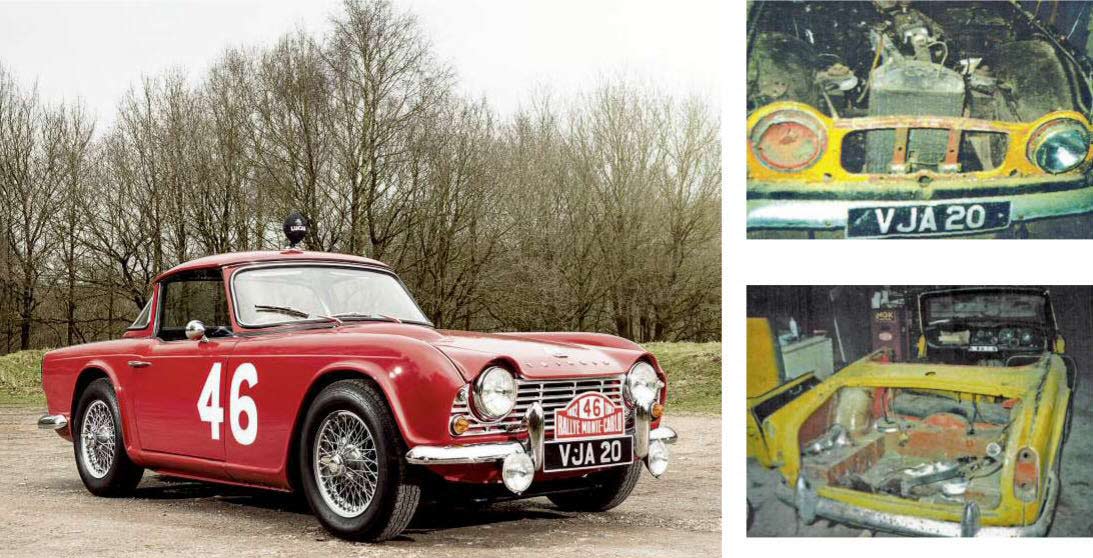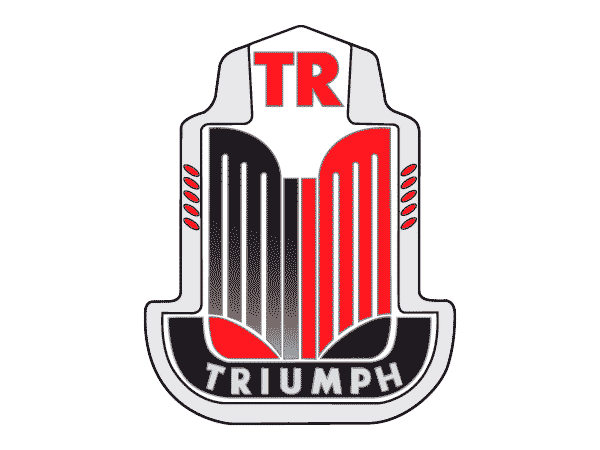
Monte Carlo and bust Triumph TR4 1962 Monte Carlo crasher driven. We bury the throttle in the Triumph TR4 that colourful JP and full-time speed-addict Edwin Hodson drove – and crashed – on the 1962 Monte Carlo rally. Words John Simister. Photography Alex Tapley.
Triumph TR4 We grab a TR4 – the privately entered car that beat Triumph’s own works cars to the Monte Carlo Rally back in 1962 – by the scruf of the neck on a high-speed tarmac blast.
International rallying used to be quite simple. You’d buy a car strong enough and sporting enough to last the course and get to the finish on time, fit extra lights and navigational aids, pay your entry fee and off you’d go to Monte Carlo, Liège, Athens or wherever. The works teams did it on a bigger scale with more service back-up and greater thoroughness of course but in theory anyone sufficiently well-heeled could have a go.

My mission today is to experience not just any old Triumph TR4 rally car but a veteran of the 1962 Monte Carlo Rally that owner, entrant and driver Edwin Hodson – ironically hailed by the more jingoistic reaches of the British press as ‘the fastest man on ice’ – ran without studded tyres and inverted on the icy Col du Cucheron towards the end of the rally.
It looks pretty much standard from the outside apart from a pair of extra underbumper lights at the front, a heavily cranked left-hand windscreen wiper – the better to sweep close to the nearside screen pillar – and a swivelling roof light whose handle pokes down through the hardtop. A hefty front anti-roll bar is also visible, something the TR4 didn’t have originally. The paint is fabulous and the panel gaps extraordinarily good for a bolt-together separate-chassis TR4. All it needs is its original white triangular cross-section Ace numberplate digits instead of the pressed-aluminium plates it wears today. Details, details… Inside there’s a crackle-black panel in place of the glovebox lid, containing a giant clock and room for a Halda Speed Pilot or similar. Modern fuses and relays are visible behind the dashboard but otherwise all is standard, albeit renovated and retrimmed.
Attempting to find a decent driving position is helped by the flat woodrim Moto-Lita steering wheel’s reach adjustment but thwarted by a fixed seat backrest that’s too upright, a seat cushion that’s too high and an accelerator pedal that’s too far below the brake pedal – there’ll be no heel-and-toeing in this car. The fly-off handbrake is buried somewhere down by my left shin and finding the foot-operated dipswitch in a hurry would be difficult because it’s positioned almost as high up on the toeboard as the clutch pedal’s pivot.
However, the view down the bonnet is fantastic; the prominent bonnet bulge over the twin long-body SU H6 carburettors, the eyebrows over the headlamps and the curve of the front wings coalesce like a landscape of interlocking hills.
The tachometer needle swings into life as I fire up the engine, triggering a deep businesslike bluster from the exhaust pipe and twin pancake air filters.
Into first gear and there’s no crunch and very little resistance because the TR4’s gearbox was one of Britain’s earliest recipients of first-gear synchromesh. A perkier camshaft and custom-made four-into- one exhaust manifold – quite unlike the one pictured on the TR4’s homologation papers – promise abundant torque but it’s immediately obvious that this engine revs like no ordinary TR4 unit too. It’s triggered by a throttle action so keen that it’s hard not to progress down the road in a series of ungainly kangaroo-hops. Bumps in the road create similar issues – especially on a light throttle opening – so I opt to overcome it by driving the TR4 as a rally car deserves to be driven – fast and hard.
The tachometer scale ends at 6000rpm – a zone seldom visited by a standard TR4’s needle – but this one happily zips far beyond 5000rpm and would probably burst straight through the scale’s end given half a chance. I resist the temptation to find out because just 800 miles have passed under this TR4’s wheels since its restoration.
Instead I play tunes with the overdrive, its engagement so quick and smooth that it’s almost like having a series of three modern double-clutch transmissions with just two gears in each. Overdrive third and direct top are about the same so you can go for miles on a fast twisty road just switchflicking between third gear’s two legs.
Overdrive second is a useful gap-filler between direct second and third too. The tail is choppy and bouncy on the lever-arm rear dampers but the gearchange is light and ultra-crisp and so – perhaps surprisingly – is the steering. Combine this with the squirty torque and live rear axle and the TR feels rather like an early tuned Ford Escort, albeit one with extra structural flexibility – the solid roof panel chatters away endlessly to remind me of its permasquirming foundations.
Ultimately this TR4 isn’t especially fast – its fire is quenched significantly once overdrive top is in play – but it is a lot of fun. It also gives the strong impression that it hasn’t been driven much since the rebuild – it hasn’t really settled in or been debugged yet, hence the uncomfortable driving position, pedal snags and bouncy tail. Not that there’d be much point in doing that now because this TR4 is about to be re-purposed for the 2016 view of what a historic rally car should be.
Which poses a conundrum – an event may welcome your car’s historic interest but insist that its specification be less historic than accuracy should dictate.
So what do you do – keep the car as a historical curiosity or use it in a rally as originally intended and accept the necessary changes – and maybe some unnecessary ones if they make your car work better?
Just how far do you go?
This is exactly the problem faced by David Stanley, who recently acquired the TR4 that took part in the Monte Carlo Rally a year before Triumph’s own works cars. A major rebuild after the Monte crash, a complete restoration in the Nineties and recent refreshment mean the TR4 is now in pretty much the trim it was in pre-inversion. It’s a lovely period piece, but what exactly was it that Edwin Hodson entered into the 1962 Monte?
The Triumph competitions department stayed out of international rallying between the end of the TR3A’s era and the start of the TR4’s works rally career in 1962, but none of the four works cars – all powder blue with single-number VC-suffix registrations – was ready for the year’s first major rally, the Monte Carlo. Which is probably why Triumph was happy to supply Hodson with a TR4 for the purpose via his local dealer, Hollingdrake Motor Company of Stockport, Cheshire.
It came with a special-order engine, specifically the TR3A’s smaller homologated unit. A standard TR4 engine had a 2138cc capacity; the high-compression 1991cc unit had already proved itself in competition and this particular example bore engine number CTA/1–HE, which strongly suggested the start of a new series.
Hodson and VJA 20 – together with his co-driver Leslie Jones – made the Monte Carlo Rally reports of both Motor and Autocar and were pictured intact at the start in the former but inverted and forlornlooking in the latter. Triumph purportedly rebuilt the car free of charge after the rally, which could have been the point at which it received its current 2138cc engine whose number points to a May 1962 build date.
So what happened between then and now? The story is hazy before Roger and Sue Barker of Melksham in Wiltshire found VJA 20 lurking forlornly in a barn in 1990, a discovery reported in the February 1991 issue of Classic Cars. It was in quite a state – there was a lot of rot lurking beneath its six layers of paint and it was obviously incomplete, missing its windscreen, much of its trim, overdrive, carburettors and manifolds, one of its headlights and much else besides. The Barkers gradually gathered the correct parts together and brought the Triumph back to radiant health. Which brings us to today.
Current owner David Stanley says it’s one of just 17 TR4s built in 1961 so they don’t get much earlier than this. That said, VJA 20’s colourful history means it’s had plenty of opportunity to stray from its original factory specification.
MRM Motorsport’s Grahame Pryce – whom David has tasked with preparing and maintaining the car – explains what will need to be done to ready it for modern historic events. ‘We’ll run all the fuel and brake lines inside the car and fit skid plates underneath where they emerge. You can see how the fuel pump sticks out low at the moment, ready to be ripped off. We won’t use copper brake pipes because they flex, work-harden and then break.
‘Then we’ll rewire it so we know all the connections are reliable. You can’t have people spending thousands on entering a rally only to have it ruined by a simple terminal coming apart. We’ll also fit a roll cage and a foam-filled fuel cell – a modern hydrogen-fuelled electric propulsion system would be taking the update a touch too far.’
Not too drastic yet then. But there’s more, says Grahame. ‘There’s currently too much glass in it for a rally car so we’ll remake the side windows and wraparound rear window in Perspex or Lexan using the original glass as a mould. And we’ll fit a tab in the top of each door’s rear face, which will engage in an orifice in the B-post and should increase the car’s torsional stiffness by a good 100 per cent!
‘Regulations also demand modern seats bolted to the floor and full harnesses to lock the occupants into them. I can’t see the dynamo staying either – we’ll almost certainly replace it with an alternator. The period-looking Avon Turbosteel tyres will have to go too – we’ll fit modern Avon ZZs instead. And the dipswitch will move from the toeboard to the dashboard.’
Not too major a makeover, then. The end result should be much more rigid and considerably easier to drive vigorously thanks to the better-positioned accelerator pedal, improved seats and – presumably – lower driving position. And then what? Taking it on to the Monte Carlo Historic seems an obvious move. ‘Yes,’ David confirms, ‘I’m planning to do the Monte with the car but I skipped the 2016 event because it was too soon. The car won’t be modified a great deal and only as in period, other than modern safety items.’
This suggests that David has had the opportunity to consider some wider-ranging modifications but has resisted the temptation, preferring instead to keep the TR4 as close to its Sixties state as he is allowed to do. It’s a great outcome – the TR4 remains a period piece but, as Grahame Pryce says, ‘It should be used – that’s what it was built for.’
Thanks to: Grahame Pryce at MRM Motorsport
Tech and photos
TECHNICAL DATA FILE SPECIFICATIONS TRIUMPH TR4 (STANDARD SPEC)
Engine 2138cc, four-cylinder, pushrod ohv, eight valves, two SU H6 carburettors
Power and torque 100bhp @ 4600rpm; 127lb ft @ 3350rpm / DIN
Transmission Four-speed manual with optional overdrive, rear-wheel drive
Steering Rack and pinion
Suspension Front: double wishbones, coil springs, telescopic dampers. Rear: live axle, semielliptic leaf springs, lever-arm dampers Brakes
Discs front, drums rear
Weight 966kg (2130lb)
Performance Top speed: 102mph; 0-60mph: 10.9sec
Fuel consumption 26mpg
Cost new £1032 (1962 TR4)
Values now £10,500-£26,500
{module Triumph TR4}
‘It happily zips far beyond 5000rpm and would probably burst straight through the 6000rpm redline given half a chance’


EDWIN HODSON – THE SPEED – LOVING MAGISTRATE OF A KIND NOW EXTINCT
To him, every car journey was a competitive event,’ says Edwin Hodson’s son Noel in his book The Haunting of a Favourite Son. It did indeed seem that Edwin Hodson, Stockport councillor, Justice of the Peace, former Fleet Air Arm lieutenant and sometime parliamentary candidate left reality behind when he was driving a car.
Even the regular holiday drive to Cornwall was just another opportunity for him to exercise all the skills required to get a car full of six travelsick children and a nerve-shattered wife to their destination as quickly as possible.
The younger Hodson goes on to describe a night test-drive over the snowcovered Pennines in the newly acquired TR4 ahead of the Monte Carlo Rally.
On a narrow lane, speed around 80mph, they came upon a right-angled bend and a district nurse picking her way around it towards them. With no possibility of stopping in time, salvation involved flicking the Triumph up the snow-covered bank and around the Morris Minor and its panic-stricken driver. The Triumph then shot back down on to the road, pointing the optimal way to flick round the bend.
In 1965 transport minister Tom Fraser imposed a temporary blanket 70mph motorway speed limit – later to become permanent under his successor Barbara Castle – following a spate of motorway accidents in fog. Hodson disapproved of the limit and as a JP refused to try motorists accused of breaking the new limit.
The Daily Express ran a Giles cartoon on December 30 1965 to that effect and perceptive journalist and intellectual heavyweight Bernard Levin later interviewed him on television. Hodson asserted that if everyone drove at the same low speeds they would drive in convoys, lose concentration and cause motorway pile-ups. He undeniably had a point, but political and public opinion was against him.
Edwin Hodson clearly lived a charmed life behind the wheel – he reached 66 years of age before his death in 1980.







